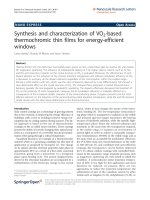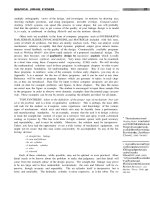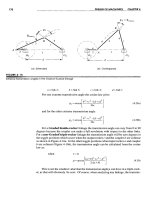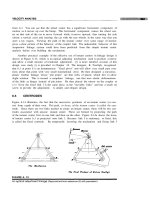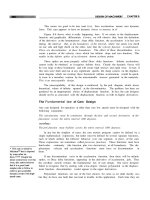Synthesis and Assembly of High Performance Nanomaterials to Create Next-Generation Energy Conversion Devices
Bạn đang xem bản rút gọn của tài liệu. Xem và tải ngay bản đầy đủ của tài liệu tại đây (1.07 MB, 1 trang )
Synthesis and Assembly of High Performance Nanomaterials to Create
Next-Generation Energy Conversion Devices
André D. Taylor, Associate Professor, Department of Chemical and Environmental Engineering,
Yale University, Mason Laboratory, 9 Hillhouse Avenue, New Haven, CT 06511 USA
/>Abstract: One of the key challenges facing the widespread use and commercialization of promising energy
devices (i.e. fuel cells, batteries, organic solar cells etc.) is the high cost of the electrocatalytic and electrolyte
materials and inefficiencies in their assembly and utilization. In this talk, I will present three examples of how
we are designing nanomaterials such as graphene-based carbons and bulk metallic glass (BMG) alloys that can
be incorporated into multifunctional composites for high performance nanostructured-enabled energy devices.
1) Electrocatalysts. We will describe a new class of materials, Pt 58Cu15Ni5P22 bulk metallic glass that can
circumvent Pt-based anode poisoning and agglomeration/dissolution typically associated with supported
catalysts during long-term operation in fuel cells. These amorphous metal alloys can serve as an interesting
platform for next-generation catalysts and devices such as the first all bulk metallic glass micro fuel cell.
2) Spin Spray Layer-by-Layer (SSLBL) Assembly. We have developed a fully automated SSLBL system with
deposition at sub-second cycle times allowing nano-level control over film growth and efficient formation of a
conducting network not available with other solution based deposition methods for lithium ion battery
electrodes.
3) Network Electrodes (See Fig.). Here we describe a technique for developing freestanding multifunctional
SWNT composite thin films that provides a fundamental engineering basis to bridge the gap between their
nano and macroscale properties for solar cell transparent conductive electrodes. We will also describe recent
efforts in using these films as active layers in hybrid SWNT/Si solar cell device as well as the use of Förster
resonance energy transfer for high efficiency polymer solar cells.
Bio: Prof. André D.
Taylor is an Associate Professor and leads the Transformative Materials and Devices Group in the Chemical
and Environmental Engineering Department at Yale University. He specializes in the synthesis and
arrangement of nanomaterials in devices such as fuel cells, lithium ion batteries, and solar cells. He received
all three degrees in chemical engineering with a BS from the Missouri University of Science and Technology,
an MS from Georgia Institute of Technology, and a PhD from the University of Michigan. While in graduate
school Taylor was a Sloan Fellow, NSF-Rackham Merit Fellow, Eastman Kodak Fellow, and GEM (MS and
PhD) Fellow. He worked as a research engineer for DuPont’s Engineering Polymers division and Intellectual
Asset Management Group and was a research faculty scientist in the chemical engineering department at the
University of Michigan. Taylor has developed CMOS compatible micro fuel cells (with integrated heaters and
temperature sensors) and a method of patterning ITO substrates for both flat and non-planar surfaces for
optoelectronic devices (Artificial Eye Project). Taylor has given several invited lectures at the local, national,
and international levels. He has several patents and archival publications related to his research. He is an NSF
CAREER award recipient and a Presidential Early Career Award in Science and Engineering (PECASE)
recipient. See website above for publication links and recent press releases from his lab.
![Tài liệu Báo cáo khoa học: Specific targeting of a DNA-alkylating reagent to mitochondria Synthesis and characterization of [4-((11aS)-7-methoxy-1,2,3,11a-tetrahydro-5H-pyrrolo[2,1-c][1,4]benzodiazepin-5-on-8-oxy)butyl]-triphenylphosphonium iodide doc](https://media.store123doc.com/images/document/14/br/vp/medium_vpv1392870032.jpg)



